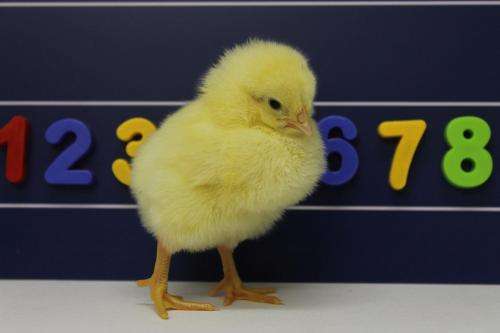January 30, 2015 report
Study shows even newly hatched chicks have a left to right number space map (w/ Video)

(Phys.org) —A team of researchers working at the University of Padova in Italy has found, that like humans, baby chickens appear to have a left to right number space map in their brains. In their paper published in the journal Science, the team describes experiments they conducted that revealed the number space mapping and describe what they believe it represents.
Brain researchers have wondered for years about the nature of number space mapping in humans—why do we think of smaller numbers on the left and bigger numbers on the right? Some have suggested it is in our genes, while others have insisted it is learned, noting that the trait seems to be reversed in people who have been raised with a language that is based on reading and writing right to left, such as Arabic. Prior research has shown that humans are not alone in the way they arrange quantity ideas in their heads, others animals such as some species of monkeys and birds have been found to do so as well, but once again, such studies have not shown whether the trait is inborn or learned. In this new study, the researchers turned to chicks to find the answer because they had not lived long enough to be exposed to number space mapping by others.
The team trained several chicks to look for food behind a card with five square blocks printed on its face. They then placed each of the chicks in a situation where they faced two cards, both of which had food hidden behind them and which had the same number of square blocks printed on their faces. The researchers found that if the number of blocks on both cards was less than five, than the chicks went for the food behind the card on the left 70 percent of the time. If both cards displayed eight blocks, the chicks tended to go for the food behind the card on the right in roughly the same proportion. The team tried changing the number of blocks, block color, size, etc. to rule out other possibilities but continued to find the same results. This they say shows that the chicks have a definite left to right number space map in their brains, and it that it is of evolutionary origin, likely coming about millions of years ago.
More information: Number-space mapping in the newborn chick resembles humans' mental number line, Science 30 January 2015: Vol. 347 no. 6221 pp. 534-536. DOI: 10.1126/science.aaa1379
ABSTRACT
Humans represent numbers along a mental number line (MNL), where smaller values are located on the left and larger on the right. The origin of the MNL and its connections with cultural experience are unclear: Pre-verbal infants and nonhuman species master a variety of numerical abilities, supporting the existence of evolutionary ancient precursor systems. In our experiments, 3-day-old domestic chicks, once familiarized with a target number (5), spontaneously associated a smaller number (2) with the left space and a larger number (8) with the right space. The same number (8), though, was associated with the left space when the target number was 20. Similarly to humans, chicks associate smaller numbers with the left space and larger numbers with the right space.
Journal information: Science
© 2015 Phys.org




















